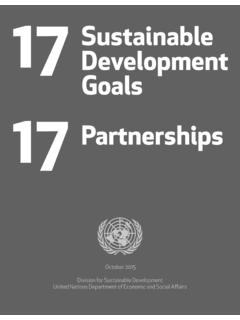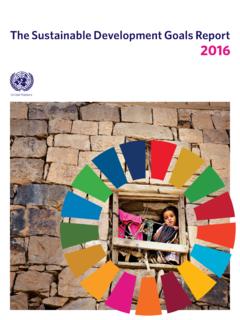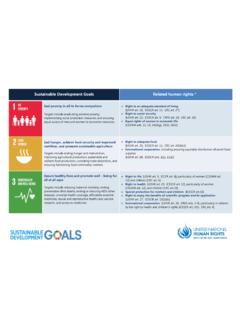Transcription of The Sustainable Development Goals Summit - un.org
1 The Sustainable Development Goals Summit 24 September - 25 September Trusteeship Council Chamber WHY DOES IT MATTER? The SDG Summit is the first UN Summit on the Sustainable Development Goals since the adoption of the landmark 2030 Agenda in 2015. The Summit is a critical opportunity to accelerate progress on the 17 Goals and their targets. The Sustainable Development Goals provide a blueprint for the transition to a healthier planet and a more just world for present and future generations.
2 With concrete targets, the Goals aim to end poverty and hunger, expand access to health, education, justice and jobs, promote inclusive and sustained economic growth, while protecting our planet from environmental degradation. Action over the last four years is producing results, and buy-in across governments and other stakeholders for the 2030 Agenda remains strong. But far more needs to be done to achieve the Goals and leave no one behind. Conflict, climate change, lack of access to essential health services, growing inequalities and significant financing gaps have limited the impact of global efforts.
3 The people left behind continue to suffer the most, including those in small island developing states, least developed countries and landlocked developing countries. The 2030 Agenda and its transformative Goals can still be achieved, but a much more urgent and ambitious response is needed. The SDG Summit will allow leaders from government, business and other sectors to demonstrate their continued strong commitment and identify specific acceleration actions that can help get the SDG response on track as we gear up for a decade of action and delivery, leading up-to the 2030 deadline.
4 WHAT IS THE FORMAT? The Summit is structured along six Leaders Dialogues. Each of the Leaders Dialogues is to be chaired by two co-moderators at the level of Head of State and Government, one from a developed country and one from a developing country, to be selected by the President of the General Assembly. Themes of the Leaders Dialogues: Megatrends impacting the achievement of the Sustainable Development Goals Accelerating the achievement of the Sustainable Development Goals : critical entry points Measures to leverage progress across the Sustainable Development Goals Localizing the Sustainable Development Goals Partnerships for Sustainable Development The 2020-2030 Vision WHAT OUTCOMES ARE EXPECTED?
5 Expected outcomes include a Political Declaration ( Gearing up for a Decade of Action and Delivery for Sustainable Development ) as well as a series of SDG acceleration actions. WHAT ARE THE LATEST FACTS AND FIGURES? Globally, the number of people living in extreme poverty declined from 36% in 1990 to 10% in 2015. But the pace of change is decelerating. Projections suggest that 6% of the world s population will still be living in extreme poverty in 2030 if current trends continue. Despite earlier extended progress, the number of people suffering from hunger has been on the rise for the third consecutive year.
6 An estimated 821 million people were undernourished in 2017, up from 784 million in 2015. The proportion of stunted children has been declining since 2000, but 22% of children under 5 years of age were still chronically undernourished in 2018. Maternal and child mortality rates have been reduced, life expectancy continues to increase globally, and the fight against some infectious diseases has made steady progress. Progress has slowed or stalled, however, on global efforts to eradicate other diseases, including malaria and tuberculosis.
7 Despite considerable progress in educational access and participation, 262 million children and adolescents (6 to 17 years old) were still out of school in 2017 -- nearly one fifth of the global population in that age group. And more than half of all children and adolescents worldwide don t meet minimum proficiency standards in reading and mathematics. Fewer girls are forced into early marriage; more women are serving in parliament and positions of leadership; and laws are being reformed to advance gender equality.
8 Despite these gains, discriminatory laws and social norms remain pervasive, along with harmful practices and other forms of violence against women and girls. While substantial progress has been made in increasing access to clean drinking water and sanitation, billions of people mostly in rural areas still lack these basic services. Two out of five people worldwide do not have a basic hand-washing facility with soap and water, and 9% of the global population still practiced open defecation in 2017. More people are using electricity than ever before.
9 Nearly 9 out of 10 people now have access to electricity. Energy efficiency continues to improve, and renewable energy is making impressive gains in the electricity sector. But three billion people still lack clean cooking fuels and technologies, putting at risk their health and the environment. Economic growth in least developed countries is again on the upswing, with real GDP growth expected to climb to in 2020, but still falling short of the 7% target. Unemployment is back to pre-financial crisis levels and labor productivity has been increasing worldwide, with consistently positive annual growth rates since 2010, but wide disparities can be found among regions.
10 The share of manufacturing in least developed countries total GDP increased by annually between 2015 and 2018, still too slow to achieve a doubling of the share in GDP by 2030. And while 90% of the world s population lived within reach of the internet in 2018, only just over 50%, and only about 20% in LDCs, could afford to use the internet. Income inequality continues to rise in many parts of the world, even though the poorest 40% of the population in most countries experienced income growth faster than the national average.














